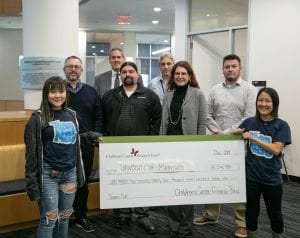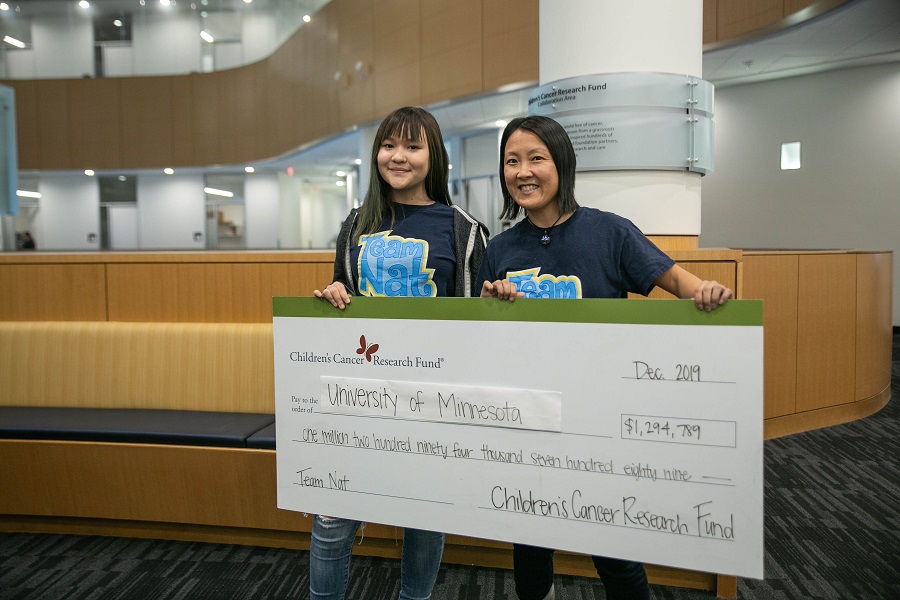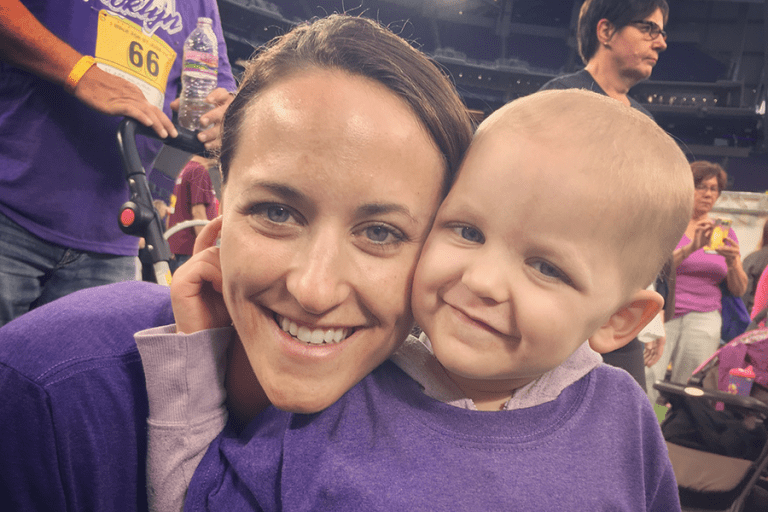Nathalia Hawley passed away in April 2019, but not before leaving an incredible and lasting mark on the world. During her fight with cancer, Nat inspired thousands of riders during Great Cycle Challenge to raise over $1 million. The money is now funding research for better treatments and cures for osteosarcoma, the disease that took her too soon.

Katy and Gabi stand with Nat's doctor and four researchers whose work Team Nat funded.
One day before what would have been Nat’s 16th birthday, Nat’s mom, Katy and sister, Gabi, met with researchers at the University of Minnesota to hear some inspiring news – because of Nat and the thousands who rallied around her, researchers are closing in on this very complex and aggressive bone cancer.
Logan Spector – the “Holy Grail” of Osteosarcoma Data
Why do normal cells turn into osteosarcoma cells? Why does osteosarcoma relapse or metastasize? How does it become resistant to treatment? These are the questions that researcher Logan Spector aims to answer using the ‘holy grail’ dataset of osteosarcoma samples. Spector is collaborating with Dr. Ken Onel from Mount Sinai, who shared this incredibly important dataset for Spector’s research. One of the reasons osteosarcoma is hard to target with treatments is that it’s great at disguising itself by changing its DNA. This is how it is able to evade the immune system, recur after being treated, and spread to other parts of the body. Using this data, Spector aims to track changes in tumors across pre-treatment, post-treatment, relapse, and metastasis.
Osteosarcoma is considered a chaotic disease – it’s hard to find one thing to target,” said Dr. Brenda Weigel, Nathalia’s oncologist. “Treatments are a long way from being universally applicable. This data will help us understand why treatments stop working so we know what steps to take next.”
Branden Moriarity and Beau Webber – Illuminating the Black Box
Could there be a way to target osteosarcoma cells without harming healthy cells? Until now,the answer was unclear. But thanks to funds from Team Nat and others, researchers Branden Moriarity and Beau Webber have discovered three major genes that help osteosarcoma flourish – genes that we didn’t know were associated with the disease. One of these genes, called SEMA4D, could potentially be a target for immunotherapies, a therapy that just targets osteosarcoma cells and leaves other areas of the body unharmed.
“There used to be a black box between normal cells and osteosarcoma cells, but now we’ve illuminated what goes on in that black box,” Moriarity said. “Our goal is to move away from chemotherapy completely and move towards therapies that are safer and more effective.”
Read more about Moriarity and Webber’s work.
Jaime Modiano – A Blood Test for Bone Cancer

Dr. Jaime Modiano rode 189 miles for Team Nat in 2019.
When a child is diagnosed with osteosarcoma, research suggests they generally fall into one of two groups – those who have a less aggressive form of the cancer, and those with a more aggressive form. This essentially means that Group A has a good chance of being alive in 10 years – and Group B does not.
Dr. Jaime Modiano’s goal is to develop a simple blood test that can tell patients, at the time of diagnosis, which group they are in so they can make decisions about how aggressively to treat their cancer as early as possible.
The goal is to be able to say ‘this is how we treat you’ rather than ‘This is how we treat bone cancer,’” Dr. Modiano said. “It’s the promise of personalized medicine.”
Read more about Dr. Modiano’s work.
Dr. Largaespada – Breaking Down Osteosarcoma’s Defenses
Osteosarcoma is an extremely aggressive cancer and when it spreads to the lungs, it becomes especially difficult to treat. This is because osteosarcoma forms a hard, calcified barrier around it that protects it from chemotherapy or other treatments that aim to destroy it. Dr. Largaespada is developing a way to knock down that barrier so chemotherapy, immunotherapy and other treatments that have yet to be developed have a clear shot at this aggressive cancer.
“These tumor barriers allows it to hide from the immune system, so if we can degrade these barriers, it may make chemotherapy and immunotherapies more effective,” said Dr. Largaespada. “And because they’ll be more effective we can use less to avoid some side effects.”
Answering Important Questions
Nathalia’s mom, Katy, said she was thankful to see so many of the industry’s top minds collaborating to end the cancer that took her daughter, some of whom had personal connections to Nat’s story. Beau Webber and Branden Moriarity started a clinical trial that Nat participated in before she passed away. Jaime Modiano rode 189 miles for Team Nat during Great Cycle Challenge 2019. Nat’s story touched thousands, and made it possible for the brightest minds in osteosarcoma research to make huge steps forward for kids like herself.
“I still have so many big questions,” Katy said. “Why did her cancer come back after it looked like she was all clear? Why did it spread like wildfire when it got to her spine? Why do kids get osteosarcoma in the first place? But I’m glad Nat is making this research possible so things can be better for other kids.”
Support More Groundbreaking Research
The dedicated supporters of Team Nat helped jump-start four projects that are changing the landscape of osteosarcoma research. Your dollar can push that research even further for kids diagnosed with cancer today. Donate at the link below to ensure that 100% of your donation goes toward osteosarcoma research.




